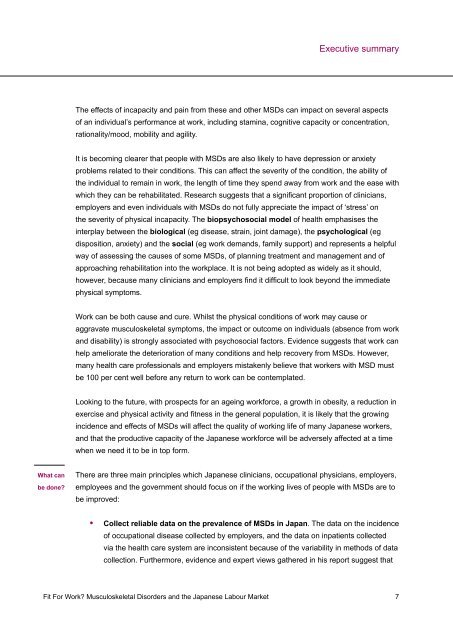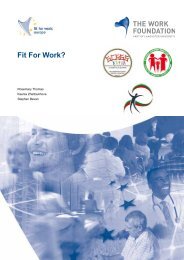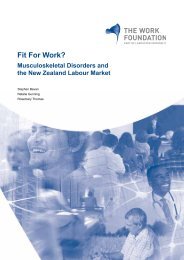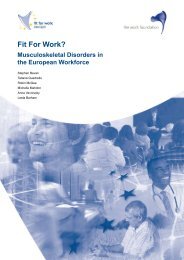English version - Fit for Work Europe
English version - Fit for Work Europe
English version - Fit for Work Europe
You also want an ePaper? Increase the reach of your titles
YUMPU automatically turns print PDFs into web optimized ePapers that Google loves.
What can<br />
be done?<br />
Executive summary<br />
The effects of incapacity and pain from these and other MSDs can impact on several aspects<br />
of an individual’s per<strong>for</strong>mance at work, including stamina, cognitive capacity or concentration,<br />
rationality/mood, mobility and agility.<br />
It is becoming clearer that people with MSDs are also likely to have depression or anxiety<br />
problems related to their conditions. This can affect the severity of the condition, the ability of<br />
the individual to remain in work, the length of time they spend away from work and the ease with<br />
which they can be rehabilitated. Research suggests that a significant proportion of clinicians,<br />
employers and even individuals with MSDs do not fully appreciate the impact of ‘stress’ on<br />
the severity of physical incapacity. The biopsychosocial model of health emphasises the<br />
interplay between the biological (eg disease, strain, joint damage), the psychological (eg<br />
disposition, anxiety) and the social (eg work demands, family support) and represents a helpful<br />
way of assessing the causes of some MSDs, of planning treatment and management and of<br />
approaching rehabilitation into the workplace. It is not being adopted as widely as it should,<br />
however, because many clinicians and employers find it difficult to look beyond the immediate<br />
physical symptoms.<br />
<strong>Work</strong> can be both cause and cure. Whilst the physical conditions of work may cause or<br />
aggravate musculoskeletal symptoms, the impact or outcome on individuals (absence from work<br />
and disability) is strongly associated with psychosocial factors. Evidence suggests that work can<br />
help ameliorate the deterioration of many conditions and help recovery from MSDs. However,<br />
many health care professionals and employers mistakenly believe that workers with MSD must<br />
be 100 per cent well be<strong>for</strong>e any return to work can be contemplated.<br />
Looking to the future, with prospects <strong>for</strong> an ageing work<strong>for</strong>ce, a growth in obesity, a reduction in<br />
exercise and physical activity and fitness in the general population, it is likely that the growing<br />
incidence and effects of MSDs will affect the quality of working life of many Japanese workers,<br />
and that the productive capacity of the Japanese work<strong>for</strong>ce will be adversely affected at a time<br />
when we need it to be in top <strong>for</strong>m.<br />
There are three main principles which Japanese clinicians, occupational physicians, employers,<br />
employees and the government should focus on if the working lives of people with MSDs are to<br />
be improved:<br />
• Collect reliable data on the prevalence of MSDs in Japan. The data on the incidence<br />
of occupational disease collected by employers, and the data on inpatients collected<br />
via the health care system are inconsistent because of the variability in methods of data<br />
collection. Furthermore, evidence and expert views gathered in his report suggest that<br />
<strong>Fit</strong> For <strong>Work</strong>? Musculoskeletal Disorders and the Japanese Labour Market 7







